Introducción
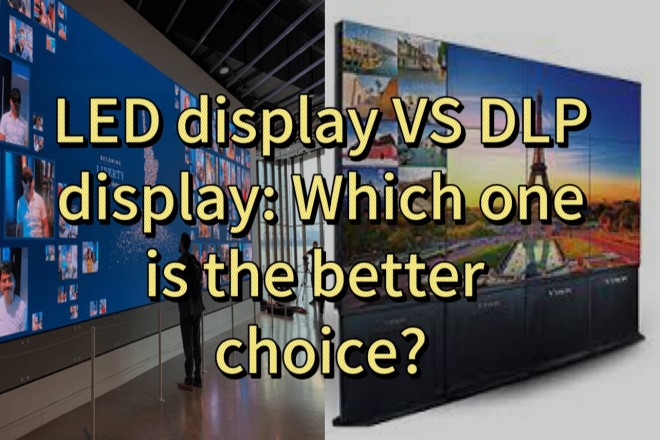
In modern display technology, pantallas LED and DLP displays have their own advantages, and choosing which one to choose often makes people hesitate.
LED is known for its seamless splicing and high brightness, while DLP is known for its high contrast and delicate image quality. This article will briefly compare the two to help you make an informed choice.
1. What are the advantages of LED display?
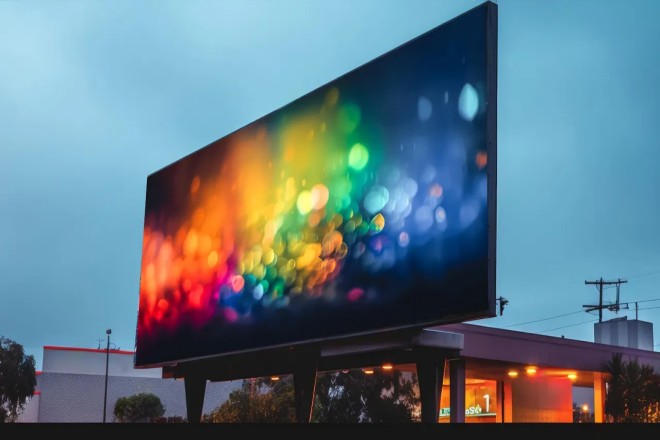
LED display screen, simply put, is a large flat-panel display composed of many small LED (light-emitting diode) lamp beads.
These LED lamp beads can emit light of various colors. Through precise control and arrangement, they can be combined into images, text, or videos, bringing us a colorful visual experience.
1). Detailed explanation of advantages:
- The miracle of seamless splicing:
Imagine if you had a very large screen, but it was made up of many small pieces with obvious gaps in the middle. It would look awkward. However, the LED display is different, and it can achieve truly seamless splicing.
This means that no matter how big your screen is, it will look like a complete screen without any gaps or gaps. This effect is particularly obvious at large-scale events, concerts, or display screens in shopping malls, giving people a shocking visual experience.
- Brillo as you wish:
The brightness of the LED display can be adjusted, and its brightness range is very wide. Whether in bright sunlight or in a dark room, the LED display can maintain a clear display effect.
This is because the LED lamp beads themselves can emit strong light, and their light is very directional and can directly shine into the eyes of the audience. Therefore, no matter what environment you watch in, the LED display can bring you a clear visual experience.
- Long life and easy maintenance:
The service life of LED displays is very long, generally reaching tens of thousands of hours. This means that once you purchase an LED display, you can go a long time without worrying about it breaking or needing frequent maintenance.
Moreover, because the LED lamp beads have a long life, the entire display screen is also very stable and is not prone to failure. This saves us a lot of time and money and allows us to focus on other important things.
2. What are the advantages of DLP display?
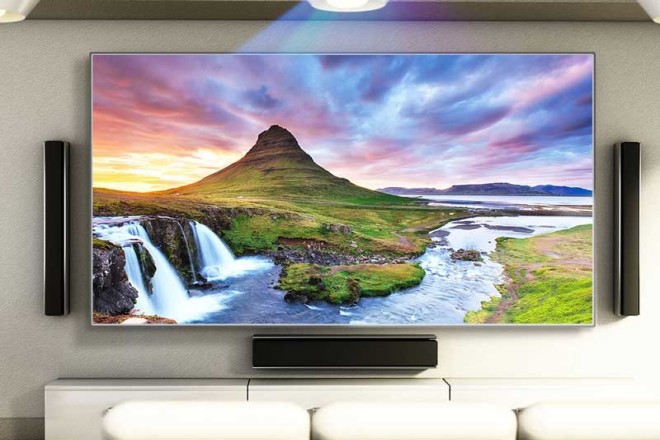
DLP, the abbreviation of “Digital Light Processing”, means digital light processing technology. It is a technology that uses a micromirror array (DMD, Digital Micromirror Device) to control light and form an image.
This technology first digitally processes the image signal, and then projects the light through a mirror array to form the image we see.
1). Detailed explanation of advantages:
- High contrast, presenting delicate pictures:
DLP technology can provide deeper blacks and finer picture details, thanks to its reflective projection principle and advanced color management technology.
When light passes through the DMD chip, only the reflected light will enter our line of sight, while the unreflected light will be absorbed or scattered, thereby reducing the impact of stray light.
This design enables the DLP display to present higher contrast and richer details when displaying high-quality images and videos, making the pictures more vivid and lifelike.
- Quick response, suitable for dynamic display:
The response speed of the DLP display is very fast, thanks to the high-speed switching capability of the DMD chip. The micro-mirrors on each DMD chip can quickly switch states in a short time to achieve precise control of light.
This high-speed switching capability allows the DLP display screen to present a smoother and more coherent picture effect when displaying dynamic video and real-time data, avoiding the problem of picture freezes or delays.
- Accurate colors and restore real scenes:
DLP technology has significant advantages in color reproduction. It uses an advanced color management system and color correction technology to ensure that the color of each pixel is accurately displayed on the screen.
This color accuracy enables DLP displays to present more realistic and natural color performance when displaying colorful images and videos, making viewers feel as if they are in a real scene.
- Long life and reduced maintenance costs:
The service life of DLP display screens is relatively long, generally reaching tens of thousands of hours. This is due to its advanced light source processing technology and heat dissipation design.
During long-term use, the DLP display screen can maintain stable performance and clear display effects, thereby reducing the frequency and cost of maintenance and replacement.
3. Comparison between the two in terms of technical parameters and performance
The following is a detailed comparison of the technical parameters and performance of LED display screens and DLP splicing screens, aiming to help readers gain a deeper understanding of the differences and respective advantages between the two:
1). Resolución
- DLP splicing screen:
The resolution is high, and the common DLP splicing screen resolution can reach 1920×1080 pixels, which ensures high-definition images.
The specific value of resolution depends on the number and configuration of DLP units. Users can choose the appropriate resolution according to their needs.
- Pantalla LED:
The resolution is determined by the dot spacing. The smaller the dot spacing, the more pixels per unit area and the higher the resolution.
The resolution of the small-pitch LED display is particularly prominent when viewed at close range, and its delicate display effect can meet the needs of high-definition and fine image and video display.
2). Brillo
- DLP splicing screen:
The brightness is moderate, generally between 700 and 1500 ANSI lumens, which is enough to meet the needs of use in general indoor environments.
In dark indoor environments, the brightness performance of DLP splicing screens is particularly good, and it can present pictures with bright colors and clear images.
- Pantalla LED:
The brightness is extremely high, usually above 2500cd/m², which allows the LED display to maintain a clearly visible display effect outdoors or in a bright indoor environment.
The brightness of the LED display can be automatically adjusted according to ambient light to ensure the best viewing effect.
3). Splicing gaps
- DLP splicing screen:
The splicing gap is small, generally around 0.5mm, which helps achieve a seamless splicing effect.
However, due to the limitations of the splicing method of DLP splicing screens, the splicing gaps may have a certain impact in some situations where gap requirements are extremely high.
- Pantalla LED:
A completely seamless splicing effect can be achieved because the LED display screen is composed of individual LED lamp beads, which can be seamlessly spliced through precise arrangement and calibration.
The seamless splicing effect provides the audience with a perfect visual experience, especially suitable for occasions that require large-area, high-definition display.
4). Other performance comparisons
- Contraste:
The contrast ratio of DLP splicing screens is usually between 1300 and 2000, which ensures that the image has rich gradients from black to white and richer color levels.
The contrast ratio of LED displays is higher, usually above 5000:1, which makes it clearer when displaying black and dark details.
- Precisión del color:
DLP splicing screens have advantages in color reproduction and can provide more realistic and natural color performance.
The color accuracy of LED displays is also high, but it may be affected by factors such as brightness and color temperature.
- Service life:
The service life of DLP splicing screens is relatively long, but the specific life span depends on the life of the light source and the stability of the system.
The service life of LED displays is longer, generally reaching tens of thousands of hours, thanks to the long life and low attenuation characteristics of LED lamp beads.
4. Analysis of the two from the application scenario
1). Application scenarios of LED display screens
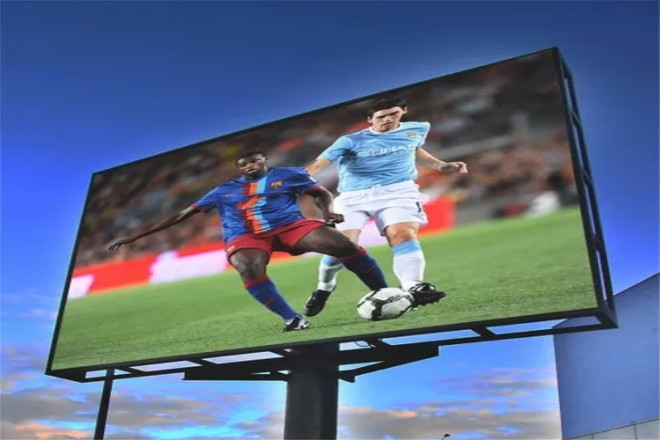
1.1). Outdoor advertising media field:
- Busy streets:
Because of its high brightness and weather resistance, LED displays are very suitable for displaying advertisements on busy streets to attract the attention of passers-by.
Inside or outside shopping malls, LED displays can be used to display promotional information, brand advertisements, etc., to enhance the shopping experience.
- Squares and parks:
In public places such as squares and parks, LED displays can be used to broadcast public service advertisements, cultural promotions and other content to enrich the cultural life of citizens.
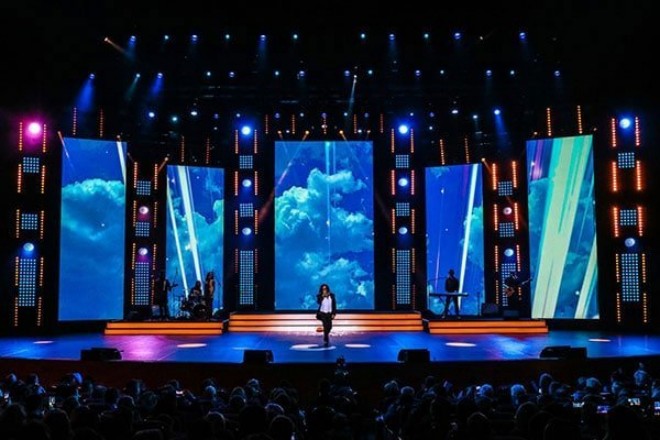
1.2). Entertainment and culture field:
- Escenario actuación:
The LED display can be used as a stage background to display images and videos related to the performance content to enhance the stage effect.
- Concierto:
At a concert, the LED large screen can be used to broadcast live images, audience interaction, and other content in real-time to enhance the audience’s sense of participation and immersion.
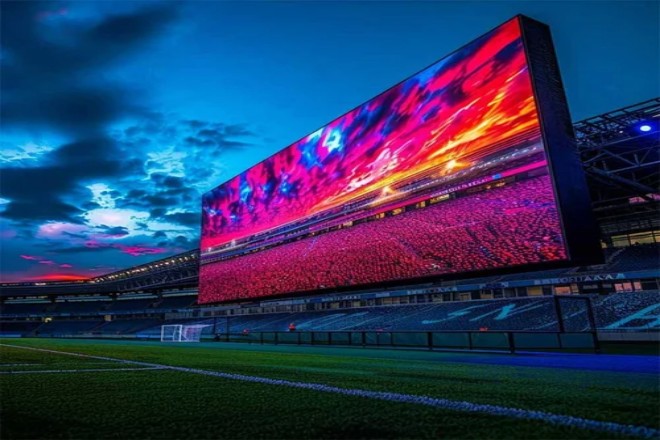
1.3). Deportes field:
- Sports venues:
LED displays can be used to display scores, game time, player information, etc., providing clear game information to the audience.
- Slow-motion replay:
In sports events, LED displays can also be used to play slow-motion replay, allowing the audience to see the highlights of the game more clearly.
2). Application scenarios of DLP display screens
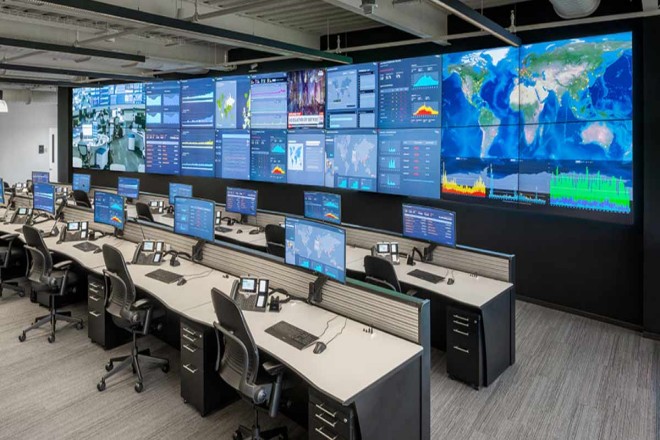
2.1). Command and Monitoring Center, Network Management Center:
DLP display screen, with its high resolution, high brightness, and high color saturation, is very suitable for use in command and monitoring centers and network management centers.
These occasions require the display of a large amount of data and information. DLP displays can ensure the clarity and readability of information and provide an accurate basis for decision-makers.
2.2). Medical imaging:
In the medical field, DLP displays can be used to display medical images, such as X-rays, CT scans, etc. Its high resolution and color accuracy help doctors diagnose conditions more accurately.
- Industrial testing:
In the field of industrial inspection, DLP displays can be used to display precise industrial images and data, helping engineers and technicians better analyze and solve problems.
- Automobile head-up display (HUD) system:
DLP technology can also be used in car head-up display systems to project key information such as navigation information and vehicle speed onto the windshield to improve driving safety and convenience.
5. How do you choose between an LED display and a DLP display?
When choosing between LED displays and DLP displays, you need to consider multiple factors, including application scenarios, resolution, brightness, splicing gaps, color accuracy, service life, and cost. Here is a comprehensive analysis of these factors to help you make an informed choice:
1) Escenarios de aplicación
1.1) Pantalla LED:
Outdoor advertising media: such as busy streets, shopping malls, squares and parks, etc., are very suitable for their high brightness and weather resistance.
Entertainment and culture field: such as stage performances, concerts, etc., can be used as a background large screen to provide colorful visual effects.
Sports field: such as score display and slow-motion replay in sports venues, providing the audience with comprehensive game information.
1.2). DLP display:
Command and Monitoring Center: Provides large-screen, multi-color, high-brightness, high-resolution display, suitable for displaying large amounts of data and information.
Medical imaging: Used to display medical images, such as X-rays, CT scans, etc., which are popular for their high resolution and color accuracy.
Industrial inspection and automotive head-up display (HUD) systems: Provide professional visualization solutions to help engineers and technicians better analyze and solve problems.
2). Cost and Maintenance
- Costo:
The cost of LED displays is gradually decreasing with the continuous advancement of technology, but the cost of high-end small-pitch LED displays is still high.
The cost of DLP displays is relatively low, but the specific price depends on the number and configuration of DLP units used.
- Maintain:
Maintenance of LED displays is relatively simple, mainly including cleaning, inspection, and replacement of damaged lamp beads.
Maintenance of DLP displays may involve replacing light bulbs, adjusting optical systems, etc., which is relatively complicated.
Conclusión
LED displays and DLP displays each have their own merits, and which technology to choose depends on specific application needs, budget and long-term operating costs.
As technology continues to develop, the boundaries between the two may become increasingly blurred, and more innovative display technologies that integrate the advantages of both may appear in the future.
Finalmente, si quieres conocer más información sobre las pantallas LED, Por favor póngase en contacto con nosotros.
